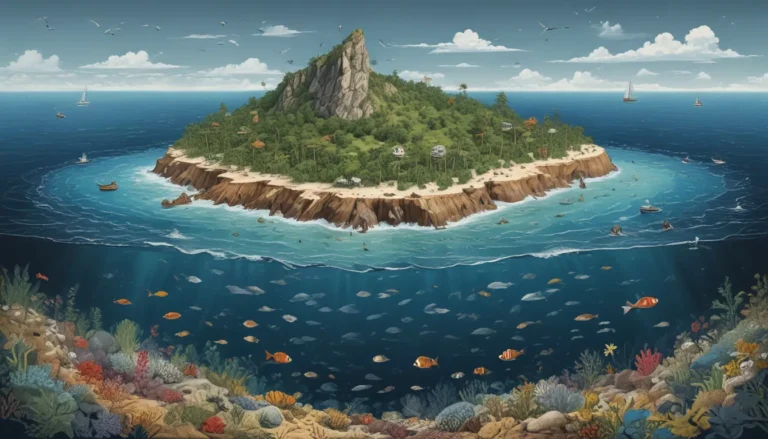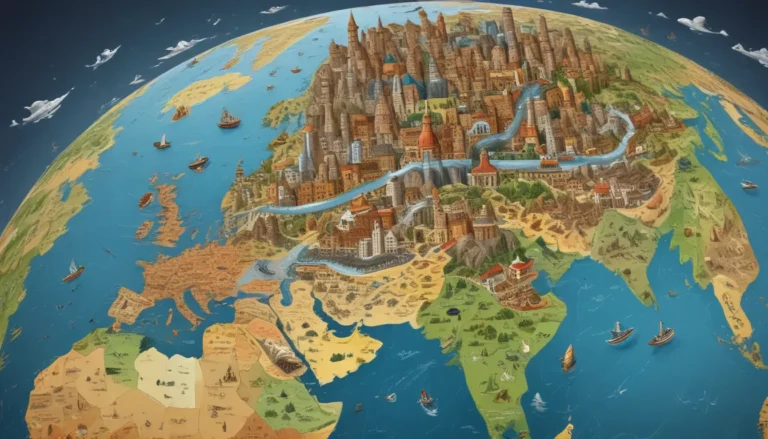A Note About Images: The images used in our articles are for illustration purposes only and may not exactly match the content. They are meant to engage readers, but the text should be relied upon for accurate information.
The world’s ocean trenches are enigmatic and captivating features that continue to intrigue scientists and explorers alike. These deep, abyssal chasms harbor a plethora of extraordinary species and offer valuable insights into Earth’s geological history. From the Mariana Trench in the Pacific to the Puerto Rico Trench in the Atlantic, each ocean trench has its own story waiting to be uncovered.
Discovering the Depths: Key Takeaways
- Ocean trenches are formed by tectonic plate movements and provide clues about Earth’s past climate and geological activity.
- The Mariana Trench, the deepest ocean trench, is home to unique deep-sea species and aids in understanding plate tectonics.
The Mariana Trench: A World Below
The Mariana Trench, located in the western Pacific Ocean, plummets to an astonishing depth of approximately 36,070 feet (10,994 meters) at its lowest point, known as the Challenger Deep. To put this into perspective, the height of Mount Everest would be dwarfed by the depths of the Mariana Trench.
The Formation of Ocean Trenches
Ocean trenches are predominantly formed at convergent plate boundaries, where one tectonic plate subducts beneath another, creating deep, narrow troughs in the ocean floor. This process gives rise to the striking topography of these underwater canyons.
Diving Deeper Than the Grand Canyon
While the Grand Canyon boasts a length of 277 miles (446 kilometers), certain ocean trenches surpass even this geological marvel. The Peru-Chile Trench, for example, spans a remarkable 3,666 miles (5,900 kilometers) along the western coast of South America, showcasing the vastness of these underwater features.
Life in the Abyss: Unique Ecosystems
Despite the challenging conditions in ocean trenches – including extreme pressure, darkness, and limited food sources – a diverse array of life thrives in these deep-sea habitats. Specialized and uniquely adapted species call these trenches home, showcasing nature’s resilience and adaptability.
Symphony of the Deep: Sounds in Ocean Trenches
The depths of ocean trenches resonate with some of the loudest sounds in the marine world. Seismic activity, hydrothermal vents, and water movements generate intense acoustic waves that reverberate through these abyssal realms, creating an orchestra of underwater sounds.
The Unleashing of Titans: Birthplaces of Tsunamis
Ocean trenches serve as the epicenters for the genesis of tsunamis, triggered by underwater earthquakes along subduction zones. The shifting tectonic plates release immense energy, displacing colossal amounts of water and giving rise to these powerful and destructive ocean waves.
Unveiling the Abyss: Manned Expeditions
Only a select few manned expeditions have successfully reached the bottom of ocean trenches due to the extreme depths and harsh conditions. The Bathyscaphe Trieste accomplished the first descent to the Challenger Deep in the Mariana Trench in 1960, paving the way for further exploration.
Time Capsules of Earth: Ancient Rocks
Ocean trenches harbor some of the oldest rocks on Earth, transported by subducting tectonic plates into the mantle. These ancient rocks, some dating back over 100 million years, offer valuable insights into Earth’s geological history and evolution.
Microbial Marvels: Thriving in Extremes
Microbial communities thrive in the extreme environments of ocean trenches, showcasing the adaptability of life forms to high pressures and low nutrient availability. These microorganisms play integral roles in nutrient cycling and energy flow within these deep-sea ecosystems.
The Enigmatic Hadal Zone
The Hadal Zone, named after the Greek underworld “Hades,” encompasses the deepest parts of ocean trenches below 20,000 feet (6,000 meters). This mysterious realm remains largely unexplored, holding untold secrets yet to be revealed.
Climate Chronicles: Insights from Ocean Trenches
Sediment layers in ocean trenches provide valuable insights into Earth’s past climate patterns. By studying these layers, scientists gain a deeper understanding of the planet’s climatic history and how it has transformed over millions of years.
Mariana Trench: A Haven for Deep-Sea Species
The Mariana Trench not only boasts unparalleled depth but also houses a plethora of unique and enigmatic deep-sea species. From translucent jellyfish to mysterious fish, these organisms have evolved to thrive in extreme conditions, captivating researchers and nature enthusiasts alike.
Nurturing Curiosity: Role in Understanding Plate Tectonics
Ocean trenches play a pivotal role in unraveling the intricacies of plate tectonics and Earth’s crustal movements. Through the study of these regions, scientists glean insights into the processes that shape our planet and drive geological activity.
Embark on a journey into the depths of ocean trenches, where each discovery unveils a world brimming with marvels and mysteries. These 13 captivating facts shed light on the significance of exploring and comprehending these extraordinary environments. From the deepest recesses of the ocean to the remarkable life forms that thrive within, ocean trenches continue to captivate our imagination and expand our knowledge of Earth’s past and future.
Delving Deeper: Conclusion
Venturing into the enigmatic depths of ocean trenches is a voyage of wonder and exploration. These abyssal canyons harbor a wealth of captivating facts that inspire both scientists and adventurers. From the unfathomable depths to the resilient ecosystems, ocean trenches stand as testaments to the beauty and complexity of our natural world.
Understanding the formation and secrets of ocean trenches offers invaluable insights into Earth’s geological processes and the resilience of life in extreme environments. Continuing our exploration and study of these submerged landscapes unveils the secrets they hold and emphasizes the significance of preserving these delicate ecosystems for future generations.
A World of Wonders: FAQs
-
What is an ocean trench?
An ocean trench is a long, narrow depression on the ocean floor formed by tectonic plate movements. -
How deep are ocean trenches?
Ocean trenches can reach staggering depths, with the Mariana Trench being the deepest known, plunging to approximately 36,070 feet (10,994 meters). -
What unique features do ocean trenches exhibit?
Ocean trenches are characterized by their steep walls, immense depths, and extreme environmental conditions, including high pressure and darkness. -
What marine life inhabits ocean trenches?
Ocean trenches are home to a variety of unique marine species, such as deep-sea anglerfish, giant isopods, and abyssal sea cucumbers, adapted to survive in harsh conditions. -
How do scientists study ocean trenches?
Scientists utilize advanced technologies, research vessels, and submersibles to map and explore ocean trenches, shedding light on their geological and biological significance. -
Are there benefits or threats associated with ocean trenches?
Exploring ocean trenches yields valuable scientific knowledge but also poses risks such as deep-sea mining and pollution that can harm these fragile ecosystems.
Embark on a journey of discovery as we unveil the mysteries of ocean trenches, showcasing the diverse wonders and complex ecosystems that inhabit these underwater realms. Dive deep into the heart of our planet’s most enigmatic features and witness the beauty and resilience of life in the abyssal depths. Join us in celebrating the marvels of ocean trenches and the importance of preserving these extraordinary environments for generations to come.






